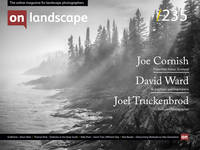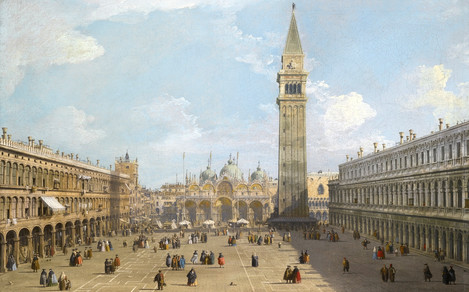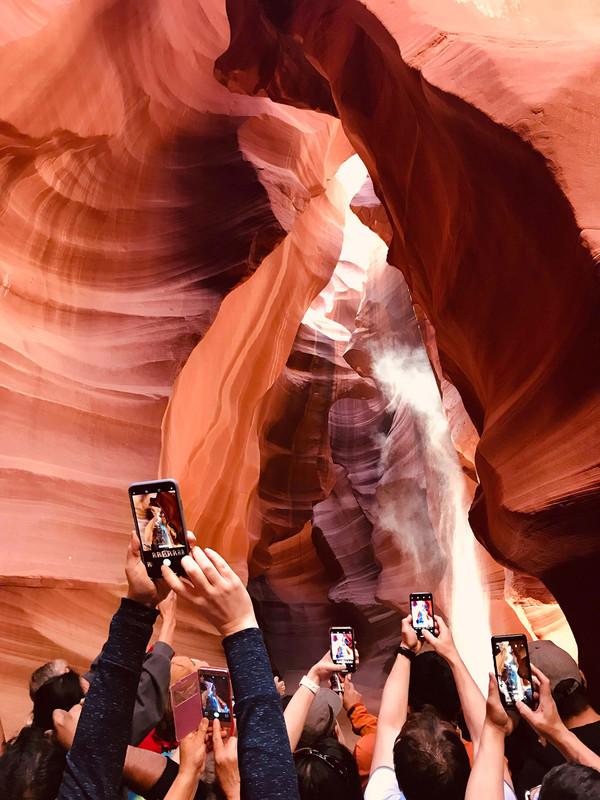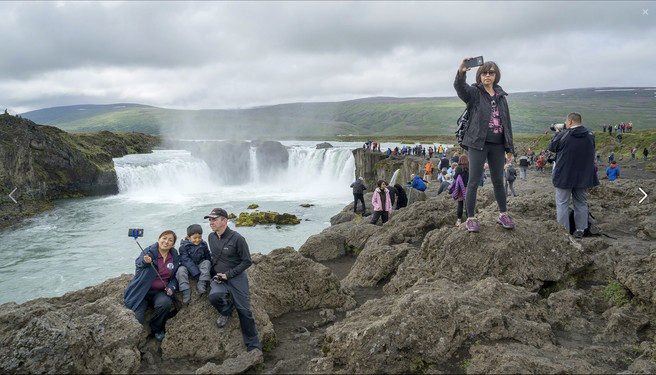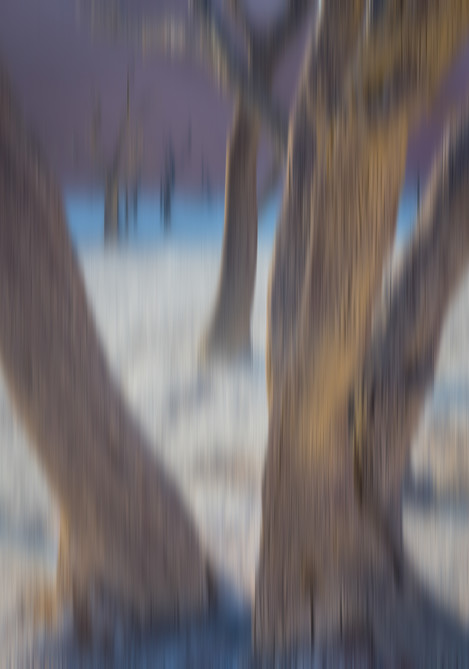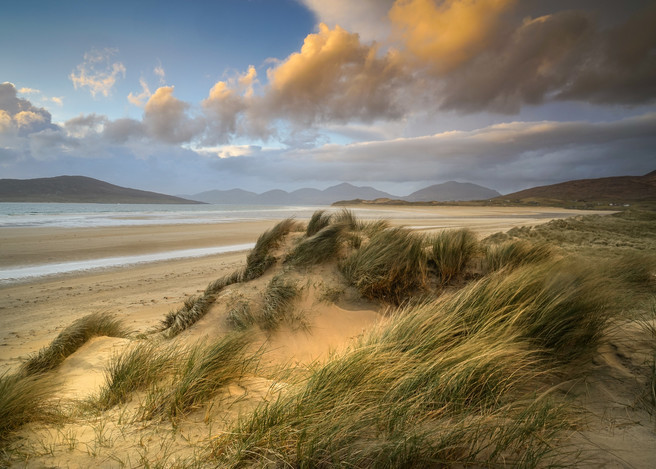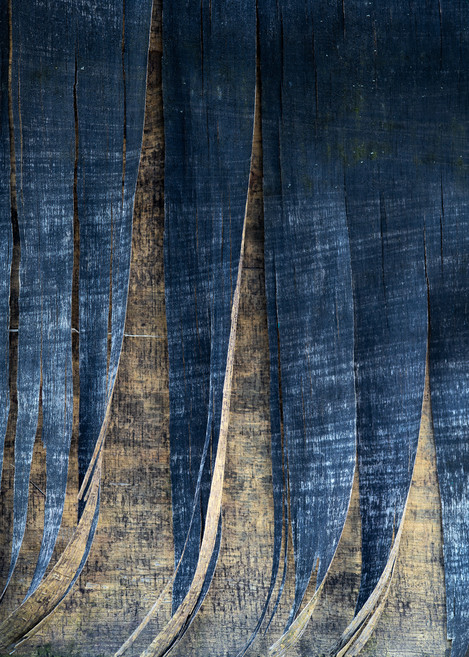Do You Work in Acquisitions?

David Ward
T-shirt winning landscape photographer, one time carpenter, full-time workshop leader and occasional author who does all his own decorating.
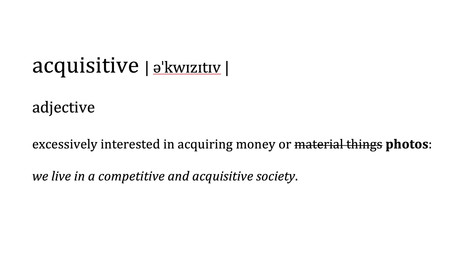
It’s been forty years since I left college and stepped out into the bright world of employment. When producing photographs to commission for magazines and advertising clients, your job is simply to acquire pleasing likenesses of faces and places to a deadline. All the “arty nonsense” I’d studied for my degree was almost immediately shoved to one side by the urgencies of work. It was exciting but also stressful. Decades later, I still have nightmares about turning up for a job having forgotten my film… or the camera battery… or lights… or arriving late… or going to the wrong address... or all of these things together on a single job!
The imperative to acquire images makes perfect sense in the world of commercial photography. Your livelihood depends upon each image fulfilling the clients’ brief. And if not, well there’s always another photographer (just out of college or a friend of the client’s) who will do it for less money and sometimes better.
However, I have long been puzzled by the sometimes aggressively acquisitive attitude of non-professional landscape photographers since there’s no client breathing down their necks.
A recent article on fstoppers.com highlighted, once again, the issue of photographers battling to secure images at a honeypot location.
In an excellent, humorous, piece of writing, Brian Christianson tells the fictional tale of a scuffle between photographers, just after dawn at Mesa Arch in Canyonlands National Park. This resulted in broken bones and $50,000 of broken gear. In the final paragraph he notes that all the ensuing fuss on social media and in the press, far from putting visitors off, resulted in a huge increase of people wanting to see sunrise through the arch.
The jockeying for position at this location is not a particularly new thing, although there are definitely more people visiting now than even twenty years ago.
My one and only visit to Mesa Arch was in 2001 on a photography tour co-led with Joe Cornish. Joe had been at least once before. We rose early for the 45min drive from Moab to the Arch, arriving well before dawn. Joe had warned us to expect other photographers, but we hoped with a 4am departure that we would be the first. A group of Germans, prototypically, had got there before us. Our party wove themselves between their tripod positions and I stood to one side. Clients come first, after all. I set up my Technika and awaited the sunrise. One of the other group came and stood next to my camera position. Just as the sun rose, he moved in front of my camera to make his images. Annoying… but I saw no reason to start a fight next to a thousand foot drop. He eventually finished and I made a couple of exposures which I was quite pleased with. My briefly interrupted view was nothing to get too het up about.
The size of the crowd (then or now) wouldn’t matter if everyone were there just to admire the view, to drink in the moment. (Although, imagine if the audience contained documentary photographers; what an opportunity!) But I challenge any of you to say, hand on heart, that you haven’t felt a frisson of annoyance because someone has got “in your way” or – even worse – walked on your pristine snow, mud, sand.
Many of the people in the recent battle would consider themselves landscape photographers. The rest might not define themselves as Instagrammers or vloggers or bloggers, but they were almost certainly planning to post their images on social media. Perhaps they simply wanted to show how wonderful their lives are or they were incentivised by ‘Likes’, craving a dopamine hit. Just don’t get in the way; Hell hath no fury like an addict denied their fix.
It’s also important to note that some of the participants in the recent ‘battle’ were paying photo tour leaders a considerable amount of money for the privilege of making images in the company of those leaders. This no doubt fed into the leader’s less than charitable response to someone wandering in front of his group to make iPhone panoramas.
All these people were united in wanting to capture a view unspoilt by the presence of fellow humans. Unless, of course, it was a selfie with (or without) their significant other. They might have been unable to verbalise their desire but basically they wanted to acquire an image of Eden before the fall from grace. They say the camera never lies when in fact it almost always lies by omission. The most frequently told lie is that you might be able to visit these places on your own. That deception is quite an incentive to travel. This humorous advert from 100% Pure New Zealand is a great example of the likely truth. https://youtu.be/Trs-isdu4eE
This is far from the only example of the acquisitive side of landscape photography. In a 2013 article for On Landscape I mention the regular autumnal dawn scraps at Maroon Bells in Colorado (Tripod Wars). Similar high tension situations also regularly arise in Zion N.P., where photographers cluster to snap The Watchman at sunset, and in Yosemite in February for the “Natural fire fall” at Horsetail Falls. Rangers at the latter location have taken the unprecedented step of closing two of the viewpoints and requiring photographers to walk for a mile-and-a-half in order to thin the crowd.
This isn’t a new phenomenon, although it has become more intense. Even before the digital era there were locations that proved so popular with photographers that access had to be limited. Frederick H Evans’ famous image “A Sea of Steps” inspired an army of copycats. This forced Wells Cathedral to take action to stop countless tripod feet eroding stone at a faster rate than generations of sandaled priests and choristers.
Not all – perhaps not even the majority – but many of these people are consuming these locations rather than communing with them; they are treating places as products. This is perhaps unsurprising given that, in the West, we are trained to become consumers from a very young age. (Sadly, I feel that many landscape photographers treat place as product on all of their photographic expeditions, not just the ones to popular locations.)
In Tripod Wars, I proposed that photography at honeypot locations can bear a similarity to competitive sport. I wonder now if it is not more akin to the mad jostling through the doors of a store on Black Friday. For me, the greatest tragedy in these often stressful circumstances is that there’s no time, in the words of W.H. Davies, to “stand and stare”, no opportunity to commune, certainly no chance to enter flow state.
We tend to think of the very-nearly mandatory act of photographing everywhere we go as an attribute of the digital era, a phenomenon that has arisen due to the unholy alliance of social media, digital “capture” and the ubiquity of mobile phones. After all, everyone – as the well-worn line goes – is a photographer now. In truth, the link between location and the desire to make an image is much older.
As Peter Osborne points out in Travelling Light, there has been a strong association between tourism and photography ever since its invention. The Acropolis, in Athens, was first photographed in October 1839. Frenchman Pierre-Gustav Joly de Lotbinière used the new method barely eight weeks after the French Academy of Sciences had gifted Louis Daguerre’s invention to the world. (Presumably he was Daguerreotypist since the term photographer had not yet been coined?) Despite not being the only photographer on his expedition, De Lotbinière is credited with being the very first ‘travel photographer’. His image unintentionally became a marketing shot for the nascent tourism industry. This was, however, far from the first time that images of exotic locations had effectively been used to sell trips.
For over 150 years prior to the Napoleonic Wars, The Grand Tour was an almost compulsory multi-year jolly around Europe for the scions of England’s great families. The Tour was undertaken almost exclusively by males. Ostensibly its purpose was to provide the first tourists with an education in history, architecture, music, and other arts. Theory, however, didn’t always align well with practice. In The Meaning of Travel, Emily Thomas describes the travails of the “bears”, those charged with steering the out-of-towners away from gold-diggers and dens of gambling or debauchery. Along with frittering away the family silver on dubious pleasures, the Grand Tourists also commissioned paintings and sketches from well-known artists as mementoes. These in turn inspired others to visit particular locations.
For a certain class of people, this was the golden age of travel; a time when only a select few (Englishmen!) went to places that are now rammed with the great unwashed. From this viewpoint the rot set in in 1841- just two years after de Lotbinière’s “first travel photo” - when an Englishman named Thomas Cook founded his famous travel agency. We might think that finding too many tourists at a location is a modern phenomenon but the Irish novelist Charles Lever railed against Cook’s early clients, writing that “…the cities of Italy are deluged with droves of these creatures.” He describes Cook’s service as reducing “…the traveller to the level of his trunk” and obliterating “every trace of the individual.” Sound familiar? Lever even went so far as to suggest to Italian friends that, because Australia was fed up with being a penal colony, Great Britain was now sending her convicts to the continent posing as tourists.
This was the very beginning of the tourism pandemic. A century on from the founding of Thomas Cook, the United Nations World Tourism Organization (UNWTO) estimated that internationally there were just 25 million tourist arrivals in 1950. Sixty-eight years later this number had increased to 1.4 billion international arrivals per year. A 56-fold increase!
When Joe Cornish and I first went to Horseshoe Bend in Arizona there wasn’t a car park, you left your car by the road outside Page and walked across the desert for about a kilometre. Now there’s a “newly enlarged” parking lot for hundreds of vehicles and you must pay a minimum of $10 to park there. From memory, there were half a dozen other people when we visited in 2001. It is now the City of Page’s No. 1 attraction. When we first went to Lower Antelope Canyon you could stay all day to photograph for a flat admission charge. Now you’re only allowed on a tour, and tripods are banned.
Tell the young “togs” today how it used to be and they won’t believe you!
By incontinently sharing location info, photographers – including myself – are certainly partially to blame for some places becoming crowded.
Nature First, an organisation dedicated to helping photographers behave responsibly in the landscape, share my concern.
Somewhat ironically, seventeen years ago I received a lot of flak over the lack of captions in Landscape Within. People thought I was hoarding location info in order to deny others. I was accused of wanting to “pull up the ladder behind me”. My reticence then about naming the locations was simply because I wanted the images to stand on their own, without the mental baggage that goes with knowing where a photo was made. If I were to publish another book, I would definitely keep the info to myself, this time in order to help protect the places. By-the-by, there’s a delicious irony about photographers liberally sharing GPS coordinates on the one hand whilst wishing to have their special places to themselves on the other. I should, of course, state that people who consider themselves landscape photographers are far from being the only offenders. Even the otherwise right-on Guardian has regular features about “ best kept secrets” and “Top Ten places to visit”.
In a seeming paradox, photographers are even more upset if the majority of visitors are fellow photographers. Are they worried that all the light will be used up?
This paradox springs from the fact that photographers’ peers are seen as both their preferred audience and their competition for the acquisition of images. Photographers want to brag about where they’ve been to people who they think will appreciate it. But simultaneously they don’t want any other photographers to visit that place (at least not on the day they’re there).
For the vast majority this isn’t about commercial competition, no livelihoods are endangered – although try telling Michael Fatali, or “influencers” on Instagram that... So what is it that gets photographers’ tripods all in a tangle? It’s simply fighting over a limited resource.
We could look at motivations, such as the aforementioned desire to get a social media hit, but I don’t think this goes deep enough. Fundamentally I think the frustration (and aggro) derives not from surface motives but from a deeper mindset.
A big clue comes from the words we use to describe the act of photographing; we commonly say ‘take a photograph’. In the digital era, “Good capture!” is now a familiar compliment(?) on social media and forums.
Take and capture are obvious synonyms for acquire.
I argued in Landscape Beyond that the word ‘make’ was more appropriate since photography is a creative act. I was far from the first to take this position, indeed this is a debate as old as photography. Long before I was born Ansel Adams wrote “You don’t take a photograph, you make it!”
“Take” is problematic in many ways, not least because it can infer both a passive and an aggressive act. It can suggest that images are lying around waiting to be picked up by any passing photographer. But there’s also a hint of force, a suggestion that the subject did not surrender easily.
“Great capture” reinforces this interpretation, with a malodorous whiff of the hunt. The wonderful thing about a photo is that you don’t need a taxidermist to preserve your trophy; pixels have a near infinite shelf life and the corpse comes pickled in 2:3 aspect. We need only find a suitable means to display it so that we (and, perhaps, an audience) may feast our eyes upon it at our leisure.
It is undeniable that in one important sense photography is all about taking, all about acquisition. Photographers, like other artists, are trying to capture beauty. This is not simply something that pleases the eye, not the anodyne quality celebrated in beauty contests. It’s also much more than the prettiness typified by a beauty spot. Beauty in this sense is a combination of aesthetic qualities that also pleases the intellect, that is an expression of a deeper truth.
William Somerset Maugham put it much more eloquently: ‘Beauty is an ecstasy; it is as simple as hunger.’ Maugham’s quote suggests there’s an appetite at the base of all art. Yet you don’t see hangry writers (or painters) punching each other in front of a spectacular view. There have, of course, been artistic spats – passionate disagreements over lost commissions or who is taking the “right” approach. Clearly, taking away their pens or brushes might make them fume, but I know of no instances where blows were traded simply because two writers, or painters were creating in the same space.
The question is “What makes photographers different from writers or painters?”
Fundamentally, for the writer or painter the creative act predominantly takes place within their minds. This is only partially true for the photographer. The respective creative acts might seem on a par since the photographer’s mind mediates reality in a similar way to a writer or painter. But there is a crucial difference. What a writer or painter creates might be linked to a place or event, but it is not solely contingent on them.
A photograph, on the other hand, is inextricably determined by what is in front of the camera. It is literally impossible to divorce it from a specific time and place. We might not recognise the location from the photo (or vice versa) but – whatever manipulations are employed post facto – reality is the indispensable resource, the base ore, from which photographers fashion their vision.
Since reality is hardly in short supply, you might think the requirement to have something in front of the lens isn’t much of a constraint. The problem lies in the fact that in any field of photography the majority of practitioners tend to seek a small subset of reality. In the landscape genre that subset would include sunrise/set, golden hour, blue hour, mountains, waterfalls, beaches etc.
Surely that still leaves plenty to go at? Well, sort of...
The selection of a portion of reality is the key skill of a photographer. Reality only appears in relatively short supply because we’re overly selective. It can’t be just any waterfall, any beach, or any mountain: Only an even smaller subset of more desirable ones will do. When we see an image of a place that we like, there’s a natural desire to want to go to that place and photograph it – there is a desire to acquire it. The more alluring locations’ fame builds with every shutter click, every like and every share. This further concentrates the demand for particular variants of reality. And everyday grey skies aren’t enough; the light and/or weather needs to be spectacular or moody (or even extreme). If we imagine a Venn diagram of all these factors it becomes clear that the area of overlap gets smaller in inverse proportion to the increasing number of desirable attributes.
This competition for photo acquisition infamously reaches its peak amongst paparazzi, each elbowing and jostling for a scoop – literally a ladle – of triumph or shame. Many a subject’s life has been ruined to profit a photographer and their press baron masters.
But is it much different when countless landscape photographers’ footfalls damage an environment, crushing plants and eroding the land?
Standing in front of a truly awesome sight it’s quite hard to make an image that will not garner wows on social media. From the audience’s perspective, spectacle might easily be mistaken for artistic vision. There’s a real danger that the urge to acquire ends up extolling “being there” more than creativity. The feedback loop from social media might reinforce this flawed perception for the photographer as well.
Now, obviously, this doesn’t apply to all photographs of sunsets/waves/mountains/aurora… actually, it might apply to all the aurora photographs I’ve ever seen! There is still a skill involved in composing the image in the most powerful way. And the ability to be in the right place at the right time is also part of the skill set of any landscape photographer; reading the weather (forecast), understanding how the light will fall on a landscape at different times of day (and in different seasons), and knowing how the tides will affect what can be seen are important skills.
The examples I gave at the beginning of this article have very limited spaces from which to observe the sight or site: Mesa Arch, for instance, is 90 ft (27m) wide; The preferred view of Maroon Bells takes place along roughly 100 meters of the lake shore; The ‘natural firefall’ can only be viewed from a single designated position; Lower Antelope is narrow enough that you can touch the sides with outstretched arms. There literally isn’t room at these locations for a significant variety of compositional choices. These places are at one extreme of the reality bottleneck but there are plenty of other places that are also oversubscribed.
In these circumstances, you’re not testing your ability as a photographer; you’re simply seeing if you can be the one to grab a bargain. Even if you’re lucky enough to do so you won’t be bagging a unique, handcrafted item. At best you might be getting a personalised mass-produced commodity – you know, the kind where you pay extra to get your initials engraved on a faux silver plaque. Ask yourself how you would feel if you dressed up for a party and found that most of the attendees were wearing very similar outfits to you. Wouldn’t you rather stand out than blend in?
In part two of this article, “Nobody Expects the Inquisition”, I will be exploring how one might go about making your photography outstanding by adopting a different approach. (Clue: it’s not turning the saturation up to 60 in Lightroom…)
- Coloured engraving of Lotbinière’s Acropolis

